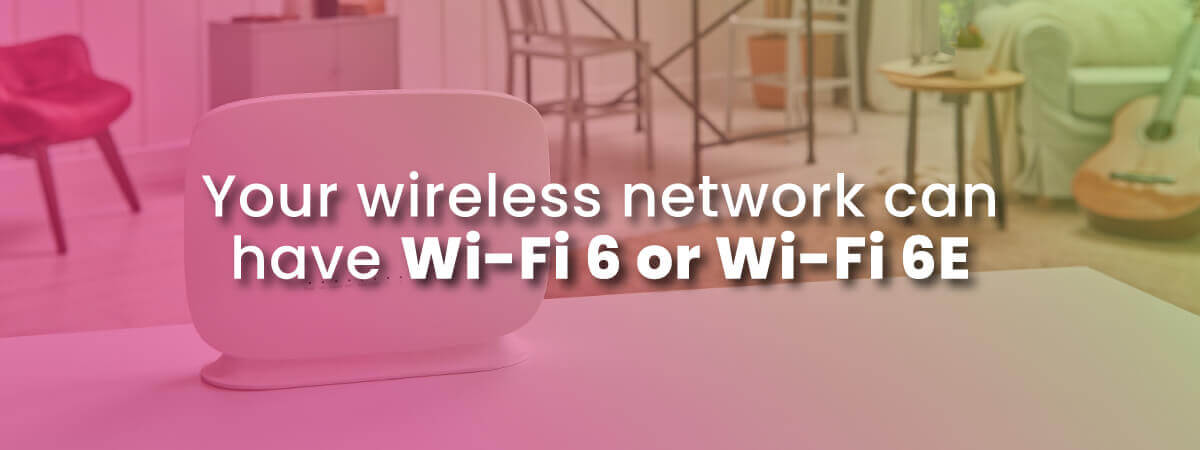Introduction to Wi-Fi 6 and Wi-Fi 6E

Table of Contents
The world of wireless technology is constantly evolving, and one of the most recent developments is the introduction of Wi-Fi 6 and Wi-Fi 6E. These new technologies have the potential to revolutionize the way we use wireless devices, offering faster speeds, better coverage, and improved battery life. In this article, we will explore the key differences between Wi-Fi 6 and Wi-Fi 6E and explain why you should consider upgrading to one of these new technologies.
What is Wi-Fi 6?
Wi-Fi 6 (also known as 802.11ax), is the latest standard for wireless networking. It was developed to improve upon the previous generation of Wi-Fi (known as 802.11ac). Wi-Fi 6 offers a number of key improvements over 802.11ac.
Wi-Fi 6 was developed to enable Wi-Fi technology to meet the growing demand for higher bandwidth and more efficient use of the wireless spectrum. Its development began in 2013 and it was standardized in 2019. Wi-Fi 6E was introduced as an extension of Wi-Fi 6, offering additional bandwidth in the 6 GHz spectrum, which was made available for Wi-Fi use by the Federal Communications Commission in 2020.
Wi-Fi 6 can improve the performance of wireless devices by increasing the speed and capacity of wireless networks. This results in improved connectivity and faster download and upload speeds for devices such as routers, tablets, laptops, and smartphones. Wi-Fi 6E also provides more available channels for devices to connect to, reducing congestion and improving reliability. These upgrades allow for a more seamless experience for users, with faster response times and fewer dropped connections, making it ideal for high-bandwidth activities such as online gaming and streaming video.
One of the major improvements of Wi-Fi 6 is the increase in throughput, or the amount of data that can be transferred per second. Wi-Fi 6 is capable of achieving speeds of up to 9.6 Gbps, which is almost four times faster than the maximum speed of 802.11ac (3.5 Gbps). This means that you will be able to download large files and stream high-definition video much more quickly when using a Wi-Fi 6 device.
Another advantage of Wi-Fi 6 is the improvement in battery life for devices. Wi-Fi 6 uses a technique called target wake time (TWT), which allows devices to sleep for longer periods of time when not in use. This means that devices can conserve battery power when they are not actively being used, which can result in longer battery life.

What is Wi-Fi 6E?
Wi-Fi 6E is an extension of Wi-Fi 6 that takes advantage of the 6GHz spectrum. This spectrum is not currently used by other wireless technologies, and thus provides a lot more bandwidth for Wi-Fi 6E to use. This means that Wi-Fi 6E devices can achieve even faster speeds and lower latency than Wi-Fi 6 devices.
The 6GHz spectrum provides a much larger bandwidth than the 2.4GHz and 5GHz spectrums that are currently used by Wi-Fi devices. This means that Wi-Fi 6E devices can achieve much faster speeds than Wi-Fi 6 devices. Additionally, the 6GHz spectrum is less crowded than the 2.4GHz and 5GHz spectrums, which means that there is less interference and more available bandwidth for Wi-Fi 6E devices to use.
How does Wi-Fi 6E compare to Wi-Fi 6?
The main difference between Wi-Fi 6 and Wi-Fi 6E is the frequency spectrum that they use. Wi-Fi 6 uses the 2.4GHz and 5GHz spectrums, while Wi-Fi 6E uses the 6GHz spectrum in addition to the 2.4GHz and 5GHz spectrums. This means that Wi-Fi 6E devices have access to a much larger bandwidth than Wi-Fi 6 devices. This larger bandwidth means that Wi-Fi 6E devices can achieve faster speeds and lower latency than Wi-Fi 6 devices.
Another advantage of Wi-Fi 6E is that it allows for more channels to be created in the 6GHz spectrum, which can help to reduce congestion in crowded areas. This is particularly beneficial for large events, such as concerts and sports games, where there are likely to be a large number of wireless devices in use at the same time.
Should you upgrade to Wi-Fi 6 or Wi-Fi 6E?
Wi-Fi 6 and Wi-Fi 6E are rapidly being integrated into today’s wireless devices such as routers, tablets, laptops, and smartphones. Many new devices are being manufactured with Wi-Fi 6 capabilities, while older devices can be upgraded through software or hardware updates. As more and more devices adopt Wi-Fi 6 and 6E, it is becoming easier for users to take advantage of the improved speed, capacity, and reliability offered by these latest generations of Wi-Fi technology. This is enabling users to enjoy better and faster wireless experiences, whether they are streaming video, playing online games, or simply browsing the web on their devices. The widespread adoption of Wi-Fi 6 and 6E is helping to drive the growth of the wireless industry and improve the connectivity and experience of users around the world.
The decision to upgrade to Wi-Fi 6 or Wi-Fi 6E will depend on your specific needs and circumstances. If you are looking for faster speeds and lower latency, then Wi-Fi 6E may be the better choice. However, it is important to note that Wi-Fi 6E devices are currently much less common than Wi-Fi 6 devices, and may be more expensive.
If you are looking for improved performance in crowded environments, then Wi-Fi 6 may be a better choice. Wi-Fi 6 devices are already widely available and are likely to be less expensive than Wi-Fi 6E devices.
It is also worth considering the devices that you currently use, and whether they are compatible with Wi-Fi 6 or Wi-Fi 6E. If your devices are not compatible with these new technologies, then upgrading your wireless network may not be worthwhile.

Summary and Takeaways: Wi-Fi 6 and Wi-Fi 6E
Wi-Fi 6 and Wi-Fi 6E are the latest advancements in wireless technology, offering faster speeds, improved performance in crowded environments, and better battery life for devices. While Wi-Fi 6E offers the potential for even faster speeds and lower latency than Wi-Fi 6, it is currently less common and may be more expensive. Ultimately, the decision to upgrade to Wi-Fi 6 or Wi-Fi 6E will depend on your specific needs and circumstances.
Takeaways:
- Wi-Fi 6 and Wi-Fi 6E are the latest advancements in wireless technology, offering faster speeds, improved performance in crowded environments, and better battery life for devices.
- Wi-Fi 6E takes advantage of the 6GHz spectrum, which has much more bandwidth than the 2.4GHz and 5GHz spectrums. The 6GHz spectrum can help to reduce congestion in crowded areas.
- Wi-Fi 6E devices can achieve even faster speeds and lower latency than Wi-Fi 6 devices, but they are currently much less common and may be more expensive.

When making the decision to upgrade to Wi-Fi 6 or Wi-Fi 6E, you should consider your specific needs, the devices you currently use, and the cost of upgrading. It’s also important to note that not all devices support Wi-Fi 6E yet, and it may take some time for the technology to become more widely adopted.
However, as technology continues to advance and more devices become Wi-Fi 6E compatible, it will become increasingly important for businesses and individuals to upgrade to take advantage of the improved speeds and performance. This is particularly true for industries that rely on high-bandwidth applications, such as streaming, gaming, and virtual reality.
In the future, it’s likely that the 6GHz spectrum will become increasingly important as more devices connect to the internet and the demand for wireless bandwidth continues to grow. It’s important to stay informed about the latest developments in wireless technology and to consider upgrading to Wi-Fi 6E when it makes sense for your specific needs.
Overall, Wi-Fi 6 and Wi-Fi 6E are exciting developments in wireless technology that promise to improve the user experience and support the growing demand for high-bandwidth applications. While there are some trade-offs to consider, such as cost and compatibility, upgrading to these technologies can help to ensure that you are getting the most out of your wireless network and staying ahead of the curve in terms of technology.
FAQs: Wi-Fi 6 and Wi-Fi 6E
What is the difference between Wi-Fi 6 and Wi-Fi 6E?
Wi-Fi 6 uses the 2.4GHz and 5GHz spectrums, while Wi-Fi 6E uses the 6GHz spectrum in addition to the 2.4GHz and 5GHz spectrums. This means that Wi-Fi 6E devices have access to a much larger bandwidth than Wi-Fi 6 devices.
What are the benefits of using Wi-Fi 6E?
The benefits of using Wi-Fi 6E include faster speeds and lower latency, improved performance in crowded environments, and more available bandwidth for devices to use. Additionally, the 6GHz spectrum is less crowded than the 2.4GHz and 5GHz spectrums, which means that there is less interference.
Are Wi-Fi 6E devices more expensive than Wi-Fi 6 devices?
Currently, Wi-Fi 6E devices may be more expensive than Wi-Fi 6 devices, but as the technology becomes more widely adopted, the price will likely decrease.
Are all devices compatible with Wi-Fi 6 and Wi-Fi 6E?
Not all devices are compatible with Wi-Fi 6 and Wi-Fi 6E yet. It’s important to check the specifications of your devices to see if they are compatible with these technologies.
Is it worth upgrading to Wi-Fi 6 or Wi-Fi 6E?
The decision to upgrade to Wi-Fi 6 or Wi-Fi 6E will depend on your specific needs and circumstances. If you are looking for faster speeds and lower latency, then Wi-Fi 6E may be the better choice. However, it’s also important to consider the cost of upgrading and the compatibility of your devices.

